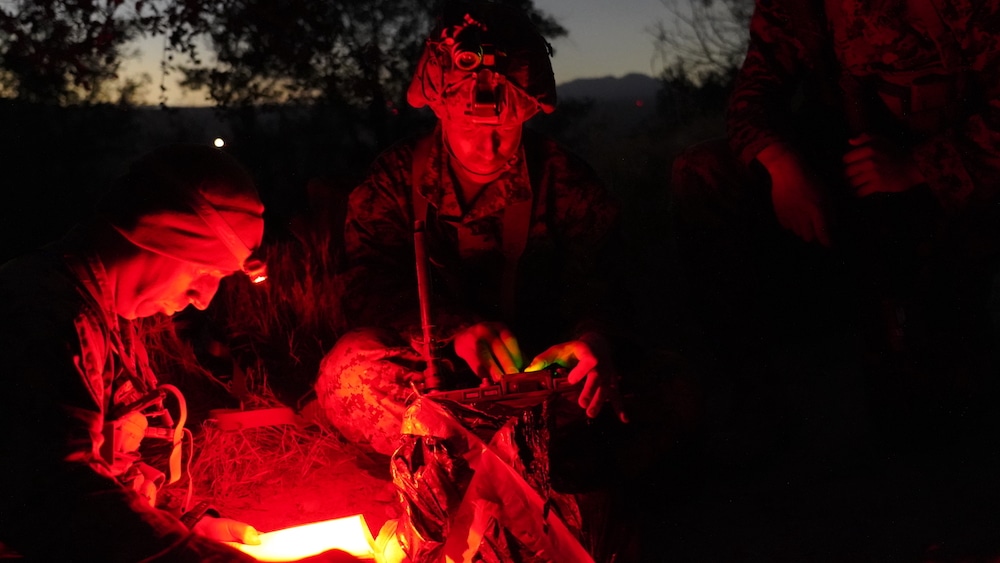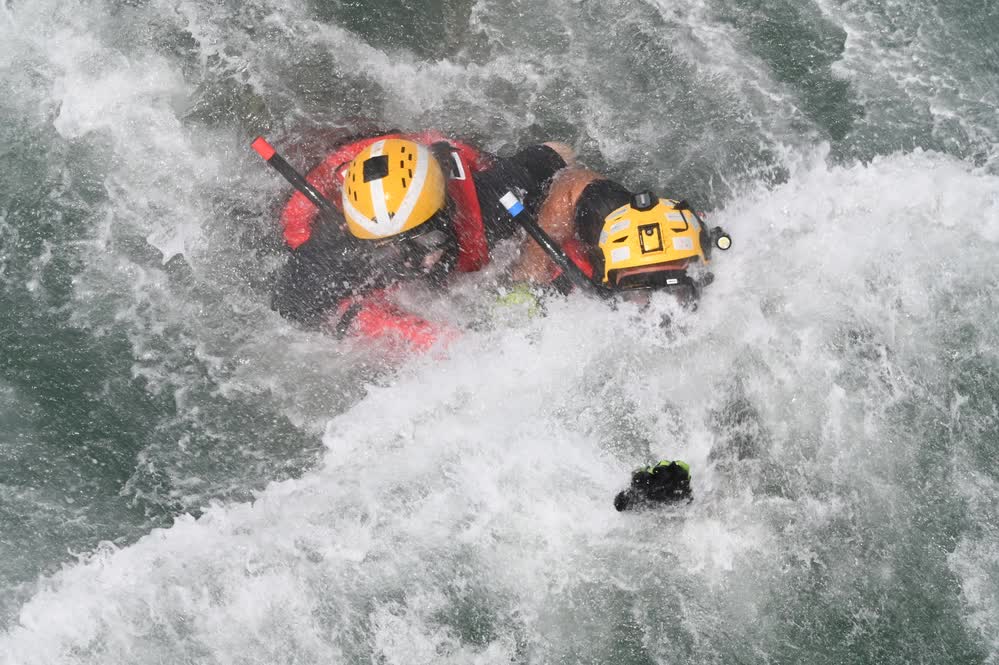This article by James R. Webb was originally published by Coffee or Die.
As Chief Warrant Officer A.J. Pasciuti led a patrol of instructors hunting his students in a steep Camp Pendleton valley, his objective was clear: They were going to find these kids, and they were going to kill ’em.
Well, that wasn’t quite right, he knew: Under the rules of the Marine Corps’ new 14-week, top-to-bottom revamped infantry training course, instructors like Pasciuti cannot refer to the students as “kids.” They are Marines, Pasciuti knew, who are to be enabled and guided.
Still, Pasciuti thought, as he and his team of instructors hunted through a moonless night, the students had only been out of boot camp for a few months. He, on the other hand, had spent years as a sniper instructor and Force Reconnaissance Marine, so this should be easy.

Related: USMC experimenting with more versatile infantrymen.
He was wrong.
The kids — sorry, student Marines — spotted Pasciuti and his patrol from hundreds of yards away. Moving carefully to not be detected, they positioned themselves so their squad’s machine guns would have maximum effect.
And then the student Marines annihilated Pasciuti and his fellow instructors. The students, less than six months from their first day of basic training, had been hunting Pasciuti and his hunters — just like they’d been trained.
In that simulated moment, Pasciuti “died” a happy man.
“I’m telling you, these guys are nasty. They’re nasty,” Pasciuti, a trainer for Infantry Training Battalion West, told Coffee or Die Magazine. He is one of the lead instructors in the Marine Corps’ newest pilot program to remake how the Corps makes Marines. “If only we had been trained this way, where would we be now?”

This Friday, the Marine Corps will graduate the class from a pilot course aimed at revolutionizing the way the service trains the infantry. The revamped Infantry Marine Course, or IMC, is nearly twice as long — 14 weeks rather than eight — and incorporates a broad range of new concepts, including cross-training students on every weapon a Marine infantry platoon carries. But beyond building new skills, there’s a heavy emphasis on entry-level Marines making independent and analytical leadership decisions.
To their surprise, instructors said last week, they are seeing students emerging from the course performing like Marines with years of experience under their belt.
“On accident, we’ve created a tactician who knows how to lead,” Lt. Col Walker Koury, commanding officer, Infantry Training Battalion West, said.

At the heart of the course is a wholesale change in how instructors interact with students. Instructors are now embedded for the entire course with a specific squad of students, acting explicitly as mentors. According to Koury, the school banned both yelling and marching on day one of training and will also not tolerate the young Marines being called “kids.” Instead, instructors are told to treat them as Marines, who are to be enabled and guided.
This new relationship with students also allows the instructors to identify strengths and weaknesses and produces better training outcomes.
“So by week five and six, [the instructor] understands that Marine ‘X’ learns this way, or maybe ‘Y’ learns like this. I can have a personal connection with my Marines and get through to them on how they learn,” Capt. David DeLong, Headquarters and Instructor Company commander for Infantry Training Battalion West, told Coffee or Die.

Another deviation from the “legacy” infantry course is that Marines are no longer trained to a specific Military Occupational Specialty such as machine gunner, rifleman, or assaultman. The new course focuses on creating an infantry Marine around an “arms room” concept, capable of employing all the weapons that an infantry platoon relies on.
Beyond hard skills such as tactics and weapons proficiency, the Marines are encouraged to think on their own and act with initiative, while instructors deliberately push decision-making down to the lowest ranks.
“We want to bring higher-level decisions down to lower levels of leadership, and allow them to be much more rapid in their decision-making process,” Pasciuti said.

Driving this change is an emphasis on “near-peer” threats, such as China, as the US pivots away from nearly two decades of counterinsurgency doctrine. According to Col. Coby Moran, the School of Infantry West commanding officer, the change in mindset marks a return to “maneuver warfare.”
The concept of maneuver warfare was laid out in the late 1980s by then-Commandant of the Marine Corps Gen. Alfred Gray. He produced Fleet Marine Force Manual 1, titled Warfighting, that lays out the doctrine as “a warfighting philosophy that seeks to shatter the enemy’s cohesion through a series of rapid, violent, and unexpected actions which create a turbulent and rapidly deteriorating situation with which [the enemy] cannot cope.” Gray called for all Marines to be “creative, thinking leaders,” not just those in command.
That philosophy pervades the new infantry course.

“We should have never gone away from that, and we’re just making Marines better at doing that,” Moran told Coffee or Die. “After we kind of settled down the [last two decades of] wars and everyone retreated back to their [command posts] and we got [unmanned aerial vehicles] up — it was high-level decision-makers pushing buttons. That’s not how maneuver warfare works.”
The entire curriculum, DeLong said, has been rethought, moving away from the “industrial” instructional method, designed to mass-produce Marines, in favor of smaller groups of students who are assigned a specific NCO.
“Our 21st-century learning model is combining technology with small-group, face-to-face instruction, getting the leaders right in front of their Marines so that the squad leader leads his 14-man squad throughout the entire [period of instruction],” DeLong said.

Previously, Marines going through infantry school were trained on specific tasks over weeklong blocks. The new course spreads out those concepts over weeks, dividing them into smaller chunks taught a few hours at a time.
“In our previous course if we would train 70 hours of marksmanship, we would train one whole week of marksmanship 12 hours a day, every day for five days, and then move on. Now what we’ve transitioned to is the two-and-a-half-hour block,” Pasciuti said.
Over the first nine weeks of the course, the Marines are taught many of the same skills that the legacy course teaches, but in ongoing blocks as instructors push the students. And throughout the process, students are pitted against one another.

“Now, it’s not just ‘I need to do the skill.’ It’s ‘I need to do the skill because I want to beat my friend in second platoon.’ We’ve really seen their progression explode. They have progressed a lot faster and a lot more than we could have ever anticipated,” said DeLong.
After nine weeks of individual instruction, the course shifts to squad-based tactics. For the next three weeks, students employ machine guns, plan patrols, and operate long-range radios.
The course ends on a five-day “capstone evaluation” that includes a student-led final exercise. Instructors accompany the students but are mostly along just for safety. The exercise belongs to the students, who plan and lead patrols across nearly 30 kilometers.

In the coming weeks, the more than 130 Marines in the pilot program will hit the fleet, and according to instructors of the course, there is a large appetite for the enhanced skill set the training is producing.
“Battalions are latching on to the model. Each platoon from the company is going to a different battalion to stand up the first littoral companies,” said 1st Lt. Mark O’Connell, SOI-W’s assistant operations officer.
The pilot program, if fully implemented, will not be the norm until 2023. Until then, the Marine Corps will continue to test the concept through three more classes at both Pendleton and at Camp Lejeune, but those running the program are hopeful that the eventual outcome will be revolutionary.
“I think what we’re doing is changing the trajectory of the infantry towards a pacing threat,” said Pasciuti, “and making sure that we don’t just win in combat, but dominate.”



